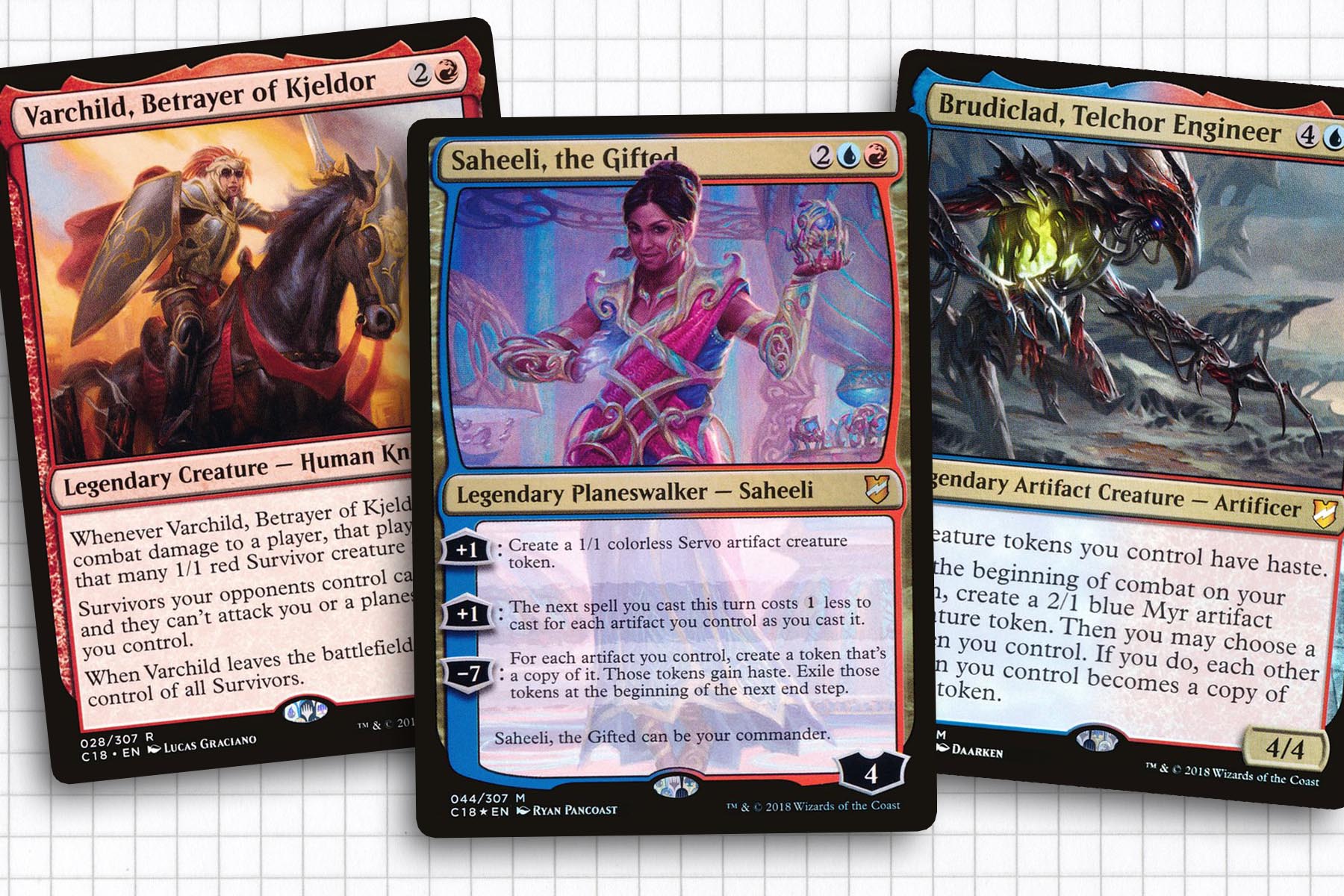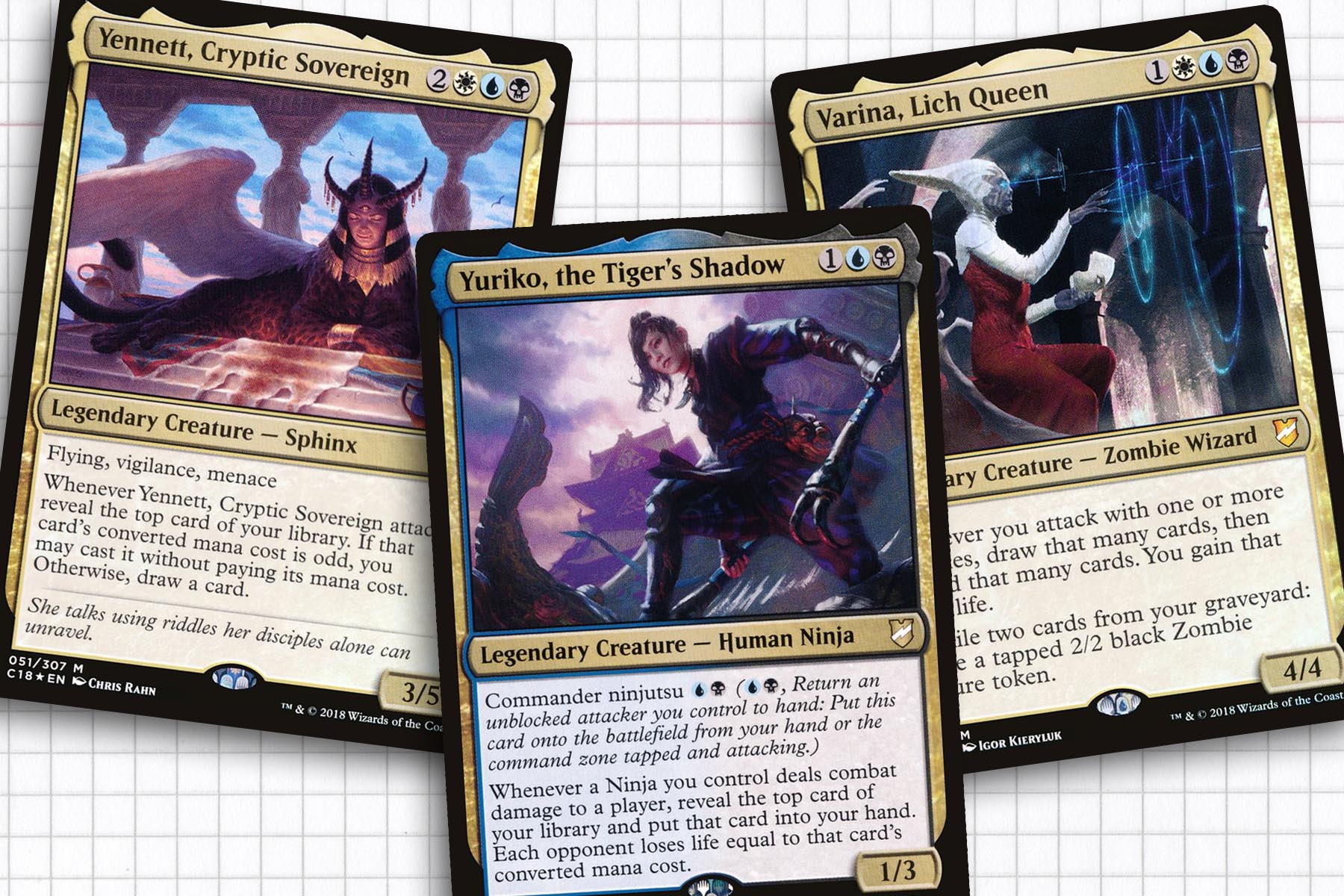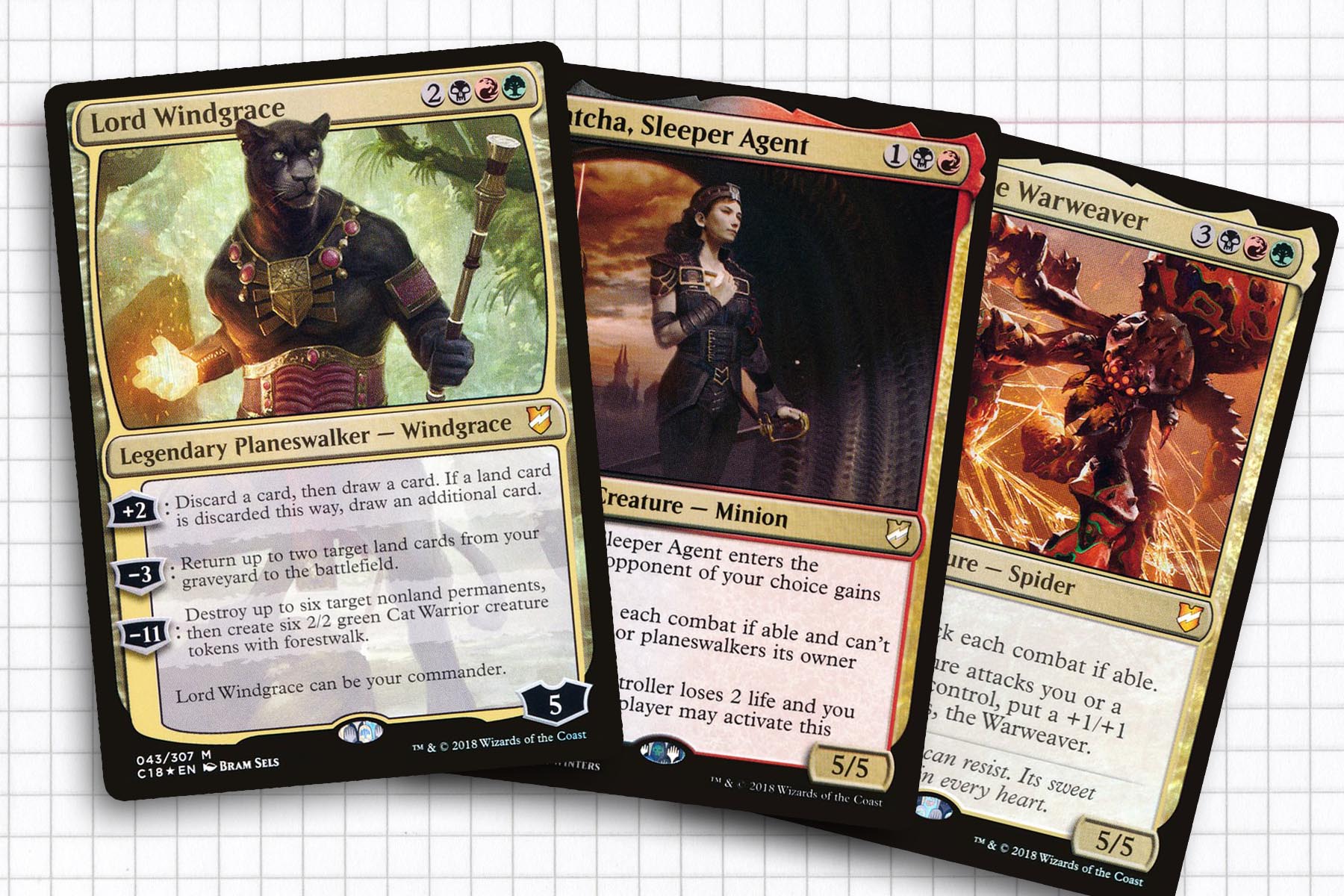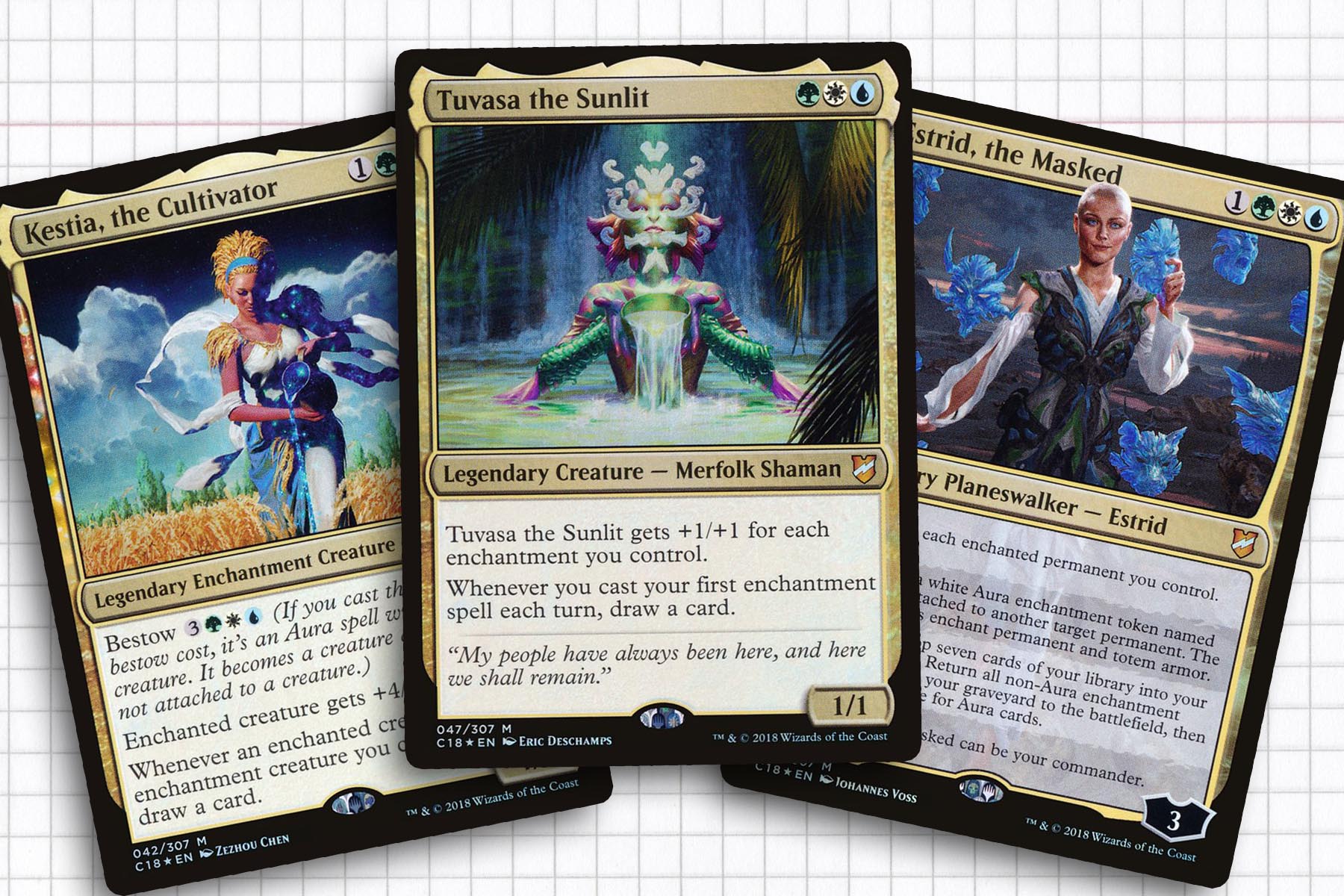Starting in 2011, Wizards of the Coast began producing special Commander sets. The project was certainly ambitious, and the intention from the beginning was to make each collection of decks thematically diverse. More than a decade later, I began revisiting the yearly Commander releases to consider their historical and contemporary performance. Check out my previous examinations: Revisiting Commander 2011, Revisiting Commander 2013, Revisiting Commander 2014, Revisiting Commander 2015, Revisiting Commander 2016, and Revisiting Commander 2017.
When looking back Commander 2018, saying that the announcement of the different themes within the product was divisive may be a bit of an exaggeration. But I think it’s fair to say that the disparate themes of enchantress, artifacts-matter, top of library-matters, and lands-matter left people with both correct and incorrect expectations for the product. In the example of the Jund lands-matter deck, I don’t precisely remember if some of the misconception on how strong the theme was originated from Gavin’s article on the design of the product or an early listing of the deck and it’s promotion text on the back of the box:
“Lord Windgrace saw his entire world devastated by the detonation of a magical device, instilling in him a hatred of artifacts. Now he commands nature to rise and join his furious war against synthetic abominations.”
Regardless of the source of the confusion, a lot of the early lukewarm reactions to aspects of the set came from the desire for some of these themes to be more thoroughly fleshed out for Commander. Enchantress has always had a strong fan base across the entire game, and Commander players had really been begging for an artifacts-matter general coming out of Kaladesh block—something that almost felt addressed with the printing of Jhoira, Weatherlight Captain. Gavin stated that one goal of the decks was to deliver on some of the most desired themes, so it’s clear the designers had their hearts in the right place.
I’ll freely admit that I didn’t have a lot of high praise for the new legendary creatures after the set was released. This was possibly due to such a high saturation of generals in Dominaria making the entire time period have a strong “if everything is special, then nothing is special” vibe. But as we will see, I think time has been very good to Commander 2018, even if I didn’t see it until now.
Today, I will be taking a look at the generals of Commander 2018, which included the second round of planeswalker-as-commander cards, and the impact the twenty new generals had on the format. I will be basing my analysis on the reception these generals received at the time, how they created or supported an archetype, and answer if they maintained any sustained usage. As always, I will be grouping each of the new commanders into the decks they premiered in.

Exquisite Invention
As time has gone on, I’ve really grown to like the Exquisite Invention deck, though it ranked in third when it came to my anticipation. As stated earlier, the Commander community had expressed some interest in seeing an artifacts-matter general in the Izzet color identity for some time, and I really think Saheeli, the Gifted put her best foot forward for the archetype.
She had a pretty meteoric rise, as out of the box, Saheeli was a very potent general that used her plus abilities to adapt to each turn of the game and could certainly easily end games with the ultimate. Saheeli currently ranks at the respectable placement of 14th among all Izzet generals on EDHrec, which indicates to me that raw drawing power of Jhoira, Weatherlight Captain has allowed her to be the optimal artifact-matter Izzet commander.
I personally just sang the praises of Brudiclad, Telchor Engineer a few weeks ago, but I think they are the biggest success of this deck. Currently ranking fifth among Izzet general, Brudiclad captured a lot of attention early on, but didn’t necessarily hit the ground running when it came time to helm a deck. This is likely in no small part due to the lower saturation of clue and treasure tokens, a more open-ended design, and being bookended by Jhoira, Weatherlight Captain and Niv-Mizzet, Parun on either side of their printing. Reinventing older Commander mainstays like Cackling Counterpart, Rite of Replication, and Myr Battlesphere in 2022; Brudilcad can be a lot of fun when running on all cylinders.
In my mind, Tawnos, Urza’s Apprentice is an interesting card that was released at the wrong time. This could have been the herald of Izzet Artifacts and had a version of this card existed even a year earlier, they could have been an upgrade from Kurkesh, Onakke Ancient for those who were looking for this kind of effect. To be fair, Tawnos has remained unique in its functionality, but I’ve never seen this card be cast and don’t know that I’ve ever seen someone inspired to build around them.
Lastly, we have Varchild, Betrayer of Kjeldor, who feels like a sweet budget politics deck just waiting for the right person to be inspired. Sadly, I think Varchild gets overshadowed in theming by Xantcha, Sleeper Agent, whom we will discuss very soon, and is a good design that just never got a chance to gain widespread attention.

Subjective Reality
I genuinely think the Subjective Reality deck was a deck that wasn’t properly understood, but still managed to contribute a solid suite of new generals. Aminatou, the Fateshifter’s most striking feature was their art, capturing the depiction of a very young child planeswalker. But the card itself was an equally cryptic puzzle, I remember staring at Aminatou and her abilities for a while before I really understood what I was looking at. Most builds use synergistic cards like Oath of Teferi, Peregrine Drake, and Felidar Guardian to create elaborate flickering board states that win in contrived ways. I happen to like playing people’s decks against themselves. She is a popular, flexible card and it should be no surprise that Aminatou ranks fifth in terms of Esper generals.
Varina, Lich Queen is really the dark horse of the deck in my opinion. As the all-but-de-facto zombie general in Esper, it’s no surprise that they come in sixth for the entire color identity. I don’t recall much of anyone clamoring for a zombie general in White, but after Amonkhet, cards like Wayward Servant and Aven Wind Guide were going to be looking for a home eventually. While the initial hype for the card has certainly died down, Varina is brought up in discussions about zombie tribal decks when Wilhelt, the Rotcleaver won’t do and a player doesn’t want to take on Green for Sidisi, Brood Tyrant.
It’s hard to be too critical of Yennett, Cryptic Sovereign; they were designed to be odd. This is especially true since they currently rank ninth in Esper overall. Top deck manipulation is crucial to this deck and over time, became a consistent place for In Garruk’s Wake, Diluvian Primordial, and Blazing Archon to all see play. In much the same way that I embraced the strange and unusual when constructing my Shattergang Brothers Eldrazi deck, Yennett gave the super gimmick “weird” decks a general to champion, all wrapped up in a fun sphinx.
Yuriko, the Tiger’s Shadow is the most important legendary creature to come out of this product. Not only as the number one general in Dimir and the second most popular general in the format, but also due to the immense sign post she acted as for Wizards to take a return to Kamigawa seriously. I understand that the design may be highly problematic, commander ninjutsu was a bit too powerful, circumventing commander tax entirely. But giving a definitive place for cards like Ninja of the Deep Hours, Tetsuko Umezawa, Fugitive, and Dimir Infiltrator to thrive was a master stroke, in my opinion, legitimizing a fifteen year old tribe. She may be “too powerful,” but at least it was with a specific suite of cards and not just in a good stuff deck kind of way.

Nature’s Vengeance
I can say with absolute certainty that I was not excited for Nature’s Vengeance on the theme alone. While I love The Gitrog Monster or Borborygmos Enraged, lands-matter had not spoken to me in the same ways most of the Commander product themes had. This bias is what made Lord Windgrace hard for me to assess. I love the idea of being able to circumvent the disadvantage of Aggressive Mining or elongate Constant Mists’ hold on a game, but I never bought into the hype that makes Windgrace the second most popular Jund general. Lord Windgrace’s abilities are all generally good depending on what you need each turn—card draw, ramp, or a miniature board wipe—so it’s easy to see how he can be the support pillar for a functioning deck without pulling a lot of attention.
When I think back to Commander 2018’s Jund deck, Thantis, the Warweaver and Gyrus, Waker of Corpses both feel out of place to some degree. In Thantis’s case, the designers have admitted that they should have just saved the design for a different set. Regardless, we get something akin to goad, before Wizards decided to fully embrace the mechanic and later additions to the deck like Frenzied Saddlebrute and Frontier Warmonger really help to push the political aspects that place Thantis at seventh overall in Jund.
Reexamining Gyrus, Waker of Corpses, they feel about as relevant to a lands-matter theme as the Eldrazi felt in Zendikar block: “You’ve got all these lands, now here’s something to do with all of them.” Gyrus has never had much of a spotlight put on them, but I can appreciate the design being Feldon of the Third Path, but aggressive. They feel like they could be a great general to support Hydra tribal, but their design doesn’t allow them to interact well with the tribal outside of setting the color identity. In the end, Gyrus feels like another Tawnos: had they been printed at a different time, they could have garnered more praise.
Lastly, we have Xantcha, Sleeper Agent, the new general within Nature’s Vengeance which cannot helm the deck. Xantcha has always felt like a popular or topical general, to the degree that I was beside myself when my research uncovered that Xantcha is the fifteenth most popular Rakdos general. I expected they would be higher on that list. I don’t know that a Rakdos donation deck was really something people were clamoring for, but in the playgroups that enjoy what Xantcha has to offer, they have always been a popular general. It’s a deck I would like to build one day, if only time allowed. Overall, I give some credit to the generals within Nature’s Vengeance all being rather open ended, if nothing else.

Adaptive Enchantment
When Enchantress deck was announced as one of the deck themes in Commander 2018, a lot of people were really excited, myself included. It seems weird now, because we have gotten a variety of decks that fit that archetype. But at the time, we only really had the Theros gods, Daxos the Returned, and Zur the Enchanter to really consider at the helm.
As the first card to go off of, Estrid, the Masked had a lot going for them, but they didn’t maintain the same momentum that other generals in Adaptive Enchantment seemingly did. Estrid’s design was moving in different directions, acting as a rather potent auras Voltron piece that, until the printing of Luxior, Giada’s Gift, couldn’t be the Voltron. They currently sit in the tenth position among Bant generals, and while I don’t expect them to move too far up the list, I could see them overtaking Roon of the Hidden Realm if the right deck list caught on.
Tuvasa the Sunlit is seemingly a beloved general within the format, currently ranking forth within the Bant color identity and seventy-fifth among all generals. Early on, people were discussing if Tuvasa would be the general to finally unite Simic and Azorius merfolk; and while it is entirely possible to use Tuvasa as a merfolk lord in name only, she has taken off far more as an aura or enchantress deck. I appreciate the design of Tuvasa, promoting the idea of casting a singular enchantment every turn, not a handful of small enchantments to chain together. All told, this merfolk has made a heck of a name for themselves.
I have learned to love Kestia, the Cultivator in a very hipster way and to some extent, I feel pretty alone in my love of the legendary enchantment creature. Kestia never felt like she captured the attention of the community—possibly due to Tuvasa existing. But I always liked that she promoted a different kind of enchantress deck, for the most part, you don’t need to worry as much about having Mesa Enchantress or Eidolon of Blossoms at the ready—Kestia is going to draw you a healthy amount of cards all on her own. This flexibility is what allowed her to helm a theme deck built around Shaman King, which excited me immensely. She currently sits at fourteenth among Bant generals. Unfortunately, we are far enough away from Kamigawa Neon Dynasty that I don’t expect any further bumps in popularity for the time being.
Without a doubt, the design of Arixmethes, Slumbering Isle is incredible. Only a kraken or leviathan could sell itself as a land, before revealing itself as a creature. Talk of a deep sea theme deck had always existed in some form, even during my early days of Commander in 2010, so it was no surprise that Arixmethes took off enough to currently sit as the ten most popular Simic general. While this theme deck has never been something on my radar, I’m happy to see that Arixmethes is at least resonating with their target audience.
Closing Thoughts
Doing this analysis has really changed how I look at this set. For a long time, I felt unfairly like Commander 2018 was the beginning of a decline in the larger Commander product line. The themes were loose enough that the set as a whole didn’t feel like a cohesive product. But the more time I’ve spent analyzing the generals, the more I realize they proved to make a huge impact on Commander across a wide swath of archetypes, intended or not.
The set is old enough that I don’t believe the saturation of extremely popular generals coming out of this product is due to recency bias. The myriad of options has been the topic of back-to-back-to-back articles by myself over the last two months. Yuriko may have single-handedly been the proof Wizards needed to bring us back to Kamigawa. I have aspirations of building around Xantcha that have just not manifested yet. And I’ve already fallen in love with Kestia, the Cultivator as the head of a deck I still have built.
So maybe it’s surprising that I had a negative perception of a set that I now realize has proven to be so fundamentally important to Commander as a whole. Until next time, thanks for reading.
Ryan Sainio is a Graphic Designer who writes about EDH and the EDH community. He has been playing Magic: the Gathering since 7th Edition in 2002 and values flavorful and fun gameplay over competitively optimized decks.

